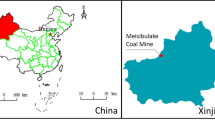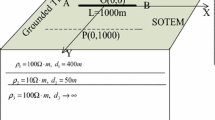Abstract
Water inrush from limestone coal beds is disastrous for coal mining. In general, it is very difficult to detect such water-enriched zones because of their relatively large burial depth. In this paper, we propose a novel transient electromagnetic method (TEM) configuration, short-offset transient electromagnetic method (SOTEM). Consistency of the results obtained from SOTEM measurements in the Shandong province, East China and drilling information indicate that the proposed TEM configuration not only improves the accuracy, but also enlarges the exploration depth for detecting water-enriched areas in coal mines ranging from 1,000 to 1,200 m depth. In this region, a majority of the deep coal beds are filled with water. The SOTEM technique was successfully employed in detecting the floor of a coal seam at a depth of about 1,500 m, as well as in identifying the location of the water-saturated area. These findings were later confirmed by subsequent drillings. Thus, our study indicates that SOTEM represents a convenient and effective technique for deep mineral and hydrogeological investigations due to its high sensitivity to conductive zones (water enriched areas) and vertical resolution.










Similar content being viewed by others
References
Alumbaugh (2002). Research proposal on 3D numerical analysis of the Grounded Electric Source, Transient Electromagnetic Geophysical Method.
Caldwell T. G. and Bibby. H.M.(1998). The instantaneous apparent resistivity tensor: a visualization scheme for LOTEM electric field measurements. Geophys. J. Int. 135, 817–834.
Cuevas N. H. and Alumbaugh D. (2009). Near source response of a resistive layer to vertical electric dipole excitation, SEG Houston 2009 International Exposition and Annual meeting: 794–798.
Hördt, A., Druskin, V.L., Knizhnerman, L.A. & Strack, K.M. (1992). Interpretation of 3-D effects in long-offset transient electrodetermine, magnetic (LOTEM) soundings in the Munsterland area, Germany, Geophysics 57, 1127–1137.
Kaufman, A. A. and Keller, G. V. (1983). Frequency and Transient Soundings, Elsevier, New York.
Michael Commer and Gregory Newman (2004). A parallel finite-difference approach for 3D transient electromagnetic modeling with galvanic sources, Geophysics 69, 1192–1202.
Nabighian, M.N. (1979). Quasi-static transient response of a conducting half-space. Geophysics 44, 1700–1705.
Nestor, H. Cuevas and David Alumbaugh. (2011). Near-source response of a resistive layer to a vertical or horizontal electric dipole excitation, Geophysics 76, 353–371.
Newman G.A. (1989). Deep transient electromagnetic soundings with a grounded source over near-surface conductors, Geophysical Journal 98, 587–601.
Peng S (1997). Investigation of engineering disasters induced by coal mining at deep depth in China. 4th Ann meeting, Geology Branch, China Coal Industry Tech Committee, Qingdao (in Chinese).
Peng S (1999). The state-of-art and the future work of engineering disasters induced by coal mining at deep depth in China. Symp Engineering and Disaster, Dept Material Science and Engineering, China NSF, Mt Jiuhua, Jianxi (in Chinese).
Raiche, A.D. and Spies, B.R. (1981). Coincident loop transient electromagnetic master curves for interpretation of two layer earth, Geophysics 46, 53–64.
Spies, B.R. (1989). Depth of investigation in electromagnetic sounding methods, Geophysics 54, 872-888.
Spies, B.R. and Parke, P.D. (1984). Limitation of large-loop transient electromagnetic surveys in conductive terrains. Geophysics 49, 902–912.
Strack, K.M., T. Hanstein and K. LeBrocq. (1989). Case histories of LOTEM surveys in hydrocarbon prospective areas, First Break 7, 467–477.
Um, E., J. Harris, and D. Alumbaugh (2010). 3D time-domain simulation of electromagnetic diffusion phenomena: A finite-element electric field approach, Geophysics 75, F115–F126.
Um, E., D. Alumbaugh, J. Harris, and Chen J.P. (2012). Numerical modeling analysis of short-offset electric-field measurements with a vertical electric dipole source in complex offshore environments, Geophysics 77, E329–E341.
Wright D., Ziolkowski A., and Hobbs B. (2002). Hydrocarbon detection and monitoring with a multichannel transient electromagnetic MTEM survey, The Leading Edge 21, 852–864.
Xue G.Q., Bai C.Y. and Yan S. (2012). Deep sounding TEM investigation method based on a modified fixed central-loop system, Journal of Applied Geophysics 76, 23–32.
Xue G. Q., Chen W. Y., Zhou N. N, et al. (2013). Short-offset TEM technique with a grounded wire source for deep sounding, Chinese Journal of Geophysics 56, 255–261.
Xue, G.Q., Yan, Y.J. and Cheng, J.L. (2011). Researches on detection of 3-D underground cave based on TEM technique. Environ Earth Science 64, 425–430.
Ziolkowski A., Hobbs B and Wright D. (2007). Multitransient electromagnetic demonstration survey in France, Geophysics 72, 197–209.
Zhang J, Shen B (2004). Coal mining under aquifers in China: a case study. Int J Rock Mech Min Sci 41(4):629–639.
Acknowledgments
This research has been supported by the State Major Basic Research Program of the People’s Republic of China (2012CB416605) and the Natural Science Foundation of China (NSFC) (grants 41174090 41174108, and 41130419). This is an open project of Key Laboratory of Mineral Resources, Chinese Academy of Sciences (5–25). The authors would like to thank Lanbo Liu and Patrick Asamoah Sakyi who helped to improve the grammar of an earlier version of this manuscript.
Author information
Authors and Affiliations
Corresponding author
Rights and permissions
About this article
Cite this article
Chen, Wy., Xue, G.Q., Muhammad, Y.K. et al. Application of Short-Offset TEM (SOTEM) Technique in Mapping Water-Enriched Zones of Coal Stratum, an Example from East China. Pure Appl. Geophys. 172, 1643–1651 (2015). https://doi.org/10.1007/s00024-014-1028-z
Received:
Revised:
Accepted:
Published:
Issue Date:
DOI: https://doi.org/10.1007/s00024-014-1028-z




